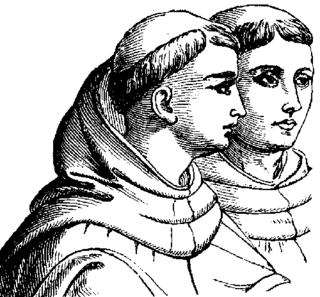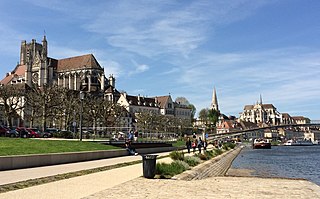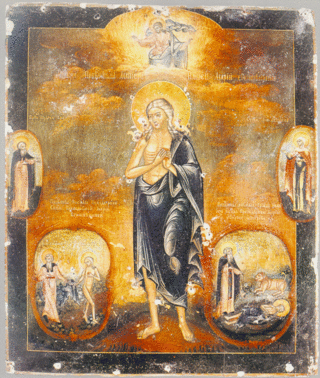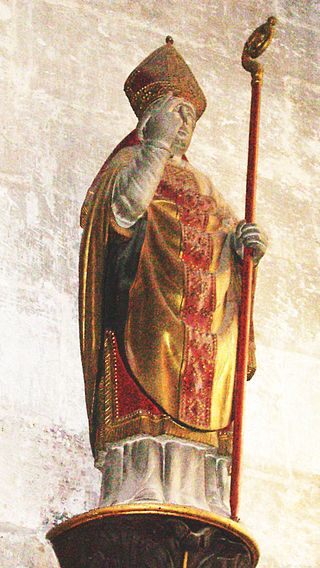Related Research Articles
Pope Celestine I was the bishop of Rome from 10 September 422 to his death on 1 August 432. Celestine's tenure was largely spent combatting various ideologies deemed heretical. He supported the mission of the Gallic bishops that sent Germanus of Auxerre in 429, to Britain to address Pelagianism, and later commissioned Palladius as bishop to the Scots of Ireland and northern Britain. In 430, he held a synod in Rome which condemned the apparent views of Nestorius.

Tonsure is the practice of cutting or shaving some or all of the hair on the scalp as a sign of religious devotion or humility. The term originates from the Latin word tonsura and referred to a specific practice in medieval Catholicism, abandoned by papal order in 1972. Tonsure can also refer to the secular practice of shaving all or part of the scalp to show support or sympathy, or to designate mourning. Current usage more generally refers to cutting or shaving for monks, devotees, or mystics of any religion as a symbol of their renunciation of worldly fashion and esteem.

Germanus of Auxerre was a western Roman clergyman who was bishop of Autissiodorum in Late Antique Gaul. He abandoned a career as a high-ranking government official to devote his formidable energy towards the promotion of the church and the protection of his "flock" in dangerous times, personally confronting, for instance, the barbarian king "Goar". In Britain he is best remembered for his journey to combat Pelagianism in or around 429 AD, and the records of this visit provide valuable information on the state of post-Roman British society. He also played an important part in the establishment and promotion of the Cult of Saint Alban. The saint was said to have revealed the story of his martyrdom to Germanus in a dream or holy vision, and Germanus ordered this to be written down for public display. Germanus is venerated as a saint in both the Roman Catholic and Orthodox churches, which commemorate him on 31 July.

An acolyte is an assistant or follower assisting the celebrant in a religious service or procession. In many Christian denominations, an acolyte is anyone performing ceremonial duties such as lighting altar candles. In others, the term is used for one who has been inducted into a particular liturgical ministry, even when not performing those duties.

Auxerre is the capital (prefecture) of the Yonne department and the fourth-largest city in the Burgundy historical region southeast of Paris. Auxerre's population today is about 35,000; the urban area comprises roughly 113,000 inhabitants. Residents of Auxerre are referred to as Auxerrois.

Sens is a commune in the Yonne department in Bourgogne-Franche-Comté in north-central France, 120 km from Paris.

Mary of Egypt was an Egyptian grazer saint dwelling in Palestine during Late antiquity or the Early Middle Ages. She is highly venerated as a Desert Mother in the Eastern Orthodox and Coptic Churches. The Catholic Church commemorates her as a patron saint of penitents.

May 7 - Eastern Orthodox Church calendar - May 9

May 27 - Eastern Orthodox Church calendar - May 29

Ignatius or Ignatios was a Patriarch of Constantinople from July 4, 847, to October 23, 858, and from November 23, 867, to his death on October 23, 877. In the Catholic Church and Eastern Orthodox churches, he is regarded as a saint, with a feast day of October 23.

Pontigny Abbey, the church of which in recent decades has also been the cathedral of the Mission de France, otherwise the Territorial Prelature of Pontigny, was a Cistercian monastery located in Pontigny on the River Serein, in the present diocese of Sens and department of Yonne, Burgundy, France. Founded in 1114, it was the second of the four great daughter houses of Cîteaux Abbey. It was suppressed in 1791 in the French Revolution and destroyed except for the church. In 1843 it was re-founded as a community of the Fathers of St. Edmund. In 1909 it passed into private ownership. In 1941 it became the mother house of the Mission de France, a territorial prelature.

Amator(in French)Amadour or Amatre was bishop of Auxerre from 388 until his death on 1 May 418 and venerated as a saint in the Catholic Church. Amator's feast day is celebrated on 1 May.

The Archdiocese of Sens and Auxerre is a Latin Archdiocese of the Catholic Church in France. The Archdiocese comprises the department of Yonne, which is in the region of Bourgogne. Traditionally established in sub-apostolic times, the diocese as metropolis of Quarta Lugdunensis subsequently achieved metropolitical status. For a time, the Archbishop of Sens held the title "Primate of the Gauls and Germania". Until 1622, the Metropolitan Archdiocese numbered seven suffragan (subordinate) dioceses: the dioceses of Chartres, Auxerre, Meaux, Paris, Orléans, Nevers and Troyes, which inspired the acronym CAMPONT. The Diocese of Bethléem at Clamecy was also dependent on the metropolitan see of Sens. On December 8, 2002, as part of a general reorganization of the dioceses of France undertaken, at least in part, to respond to demographic changes, the Archdiocese of Sens-Auxerre ceased to have metropolitan rank and became a suffragan of the Archdiocese of Dijon, which became the centre of a new ecclesiastical province for the Burgundy administrative region.

The diocese of Auxerre is a former French Roman Catholic diocese. Its historical episcopal see was in the city of Auxerre in Burgundy, now part of eastern France. Currently the non-metropolitan Archbishop of Sens, ordinary of the diocese of Sens and Auxerre, resides in Auxerre.

Saints Savinian and Potentian are martyrs commemorated as the patron saints and founders of the diocese of Sens, France. Savinian should not be confused with another early French martyr, Sabinian of Troyes.

Saints Cyrus and John are venerated as martyrs. They are especially venerated by the Coptic Church and surnamed Wonderworking Unmercenaries because they healed the sick free of charge.

The Abbey of Saint-Germain d'Auxerre is a former Benedictine monastery in central France, dedicated to its founder Saint Germain of Auxerre, the bishop of Auxerre, who died in 448. It was founded on the site of an oratory built by Germanus in honor of Saint Maurice.

Saint Maximus of Évreux, called Saint Mauxe locally, is venerated as a saint by the Catholic Church and the Eastern Orthodox Church. His legend states that he was the second bishop of Évreux, and that he died a martyr at Acquigny with his brother, who was his deacon. His brother is called Venerandus (Vénérand) or Victorinus.
Michael of Synnada or Michael the Confessor was a metropolitan bishop of Synnada from 784/7 to 815. He represented Byzantium in diplomatic missions to Harun al-Rashid and Charlemagne. He was exiled by Emperor Leo V the Armenian because of his opposition to iconoclasm, and died on 23 May 826. He is honoured as a saint by the Eastern Orthodox and Roman Catholic churches, his feast day is May 23.
Saints Helladius, Crescentius, Paul and Dioscorides are honored as Christian martyrs who were burned to death in Rome either in 244 or 326. According to Professor Mauricio Saavedra OSA, "this group was introduced by Baronius and is fictitious."
References
- ↑ Watkins, Basil. The Book of Saints: A Comprehensive Biographical Dictionary, Bloomsbury Publishing, 2015, p. 304 ISBN 9780567664150
- 1 2 "Latin Saints of the Orthodox Patriarchate of Rome". www.orthodoxengland.org.uk. Retrieved 2024-08-05.
- ↑ Goyau, Georges. "Sens." The Catholic Encyclopedia Vol. 13. New York: Robert Appleton Company, 1912
 This article incorporates text from this source, which is in the public domain .
This article incorporates text from this source, which is in the public domain . - ↑ (in Greek) Ὁ Ἅγιος Ἑλλάδιος Ἐπίσκοπος Ὡξέρρης. 8 Μαΐου. ΜΕΓΑΣ ΣΥΝΑΞΑΡΙΣΤΗΣ.
- ↑ May 8 Archived 2011-09-27 at the Wayback Machine . The Roman Martyrology.